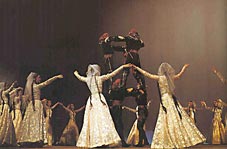More Georgian dances – Southwest Georgia
By Gvantsa Gabekhadze
Friday, April 23

Khorumi and Acharuli come from the Adjara region in southwest Georgia. Khorumi was originally performed by only a few men. However, over time it has grown in scale. In today’s version of Khorumi thirty or forty dancers can participate. Although the number of performers has changed, the content of the dance is the same. The dance brings to life the Georgian Army of past centuries. A few men searching the area for a base and enemy encampments perform the initial "prelude" to the dance. Then they call the Army onto the battlefield. The entry of the Army is quite breathtaking. The dance's strong, simple but distinctive movements and exactness of lines create a sense of awe on the stage.
Khorumi incorporates the themes of search, war and the celebration of victory and the courage and glory of Georgian soldiers. Since Georgia has seen many wars throughout its history Khorumi is a call from the past and reminds us that in order to have peace we must have war.
As for Acharuli it is distinguished from other dances by its colourful costumes and the playful mood that the simple but definite movements of both the men and women performing it create on stage. The dance is characterised by graceful, soft, and playful flirtation between the males and females. The relationship between men and women in this dance is more informal and light-hearted than in dances such as Kartuli. Acharuli instils a sense of happiness in both the dancers and the audience.
Another collective dance is Partsa, which has its origins in Guria (another region of Georgia) and is characterised by its fast pace, rhythm, festive mood and colourfulness. Partsa mesmerises the audience with not only speed and gracefulness but "live towers" of dancers. This dance creates the mood and desire to party
